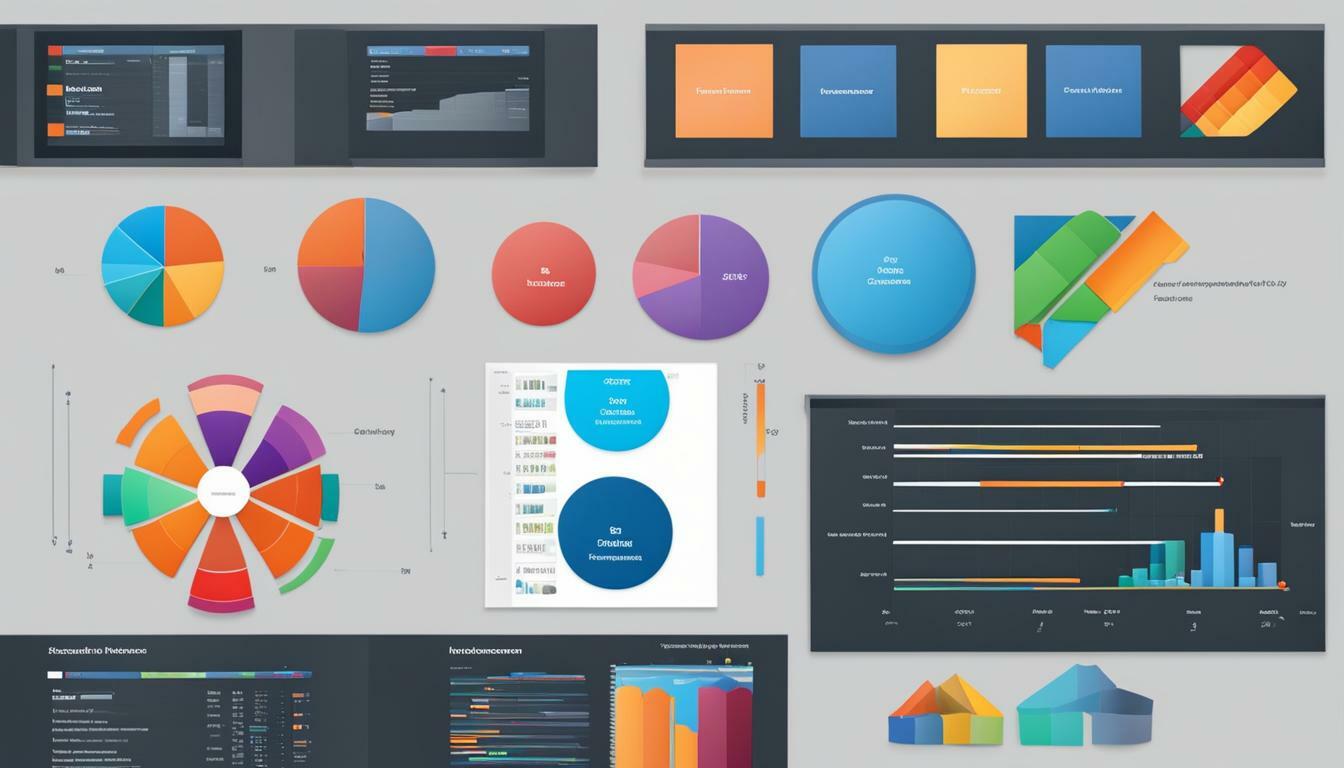When it comes to managing data, spreadsheets and databases are two popular options. While they may seem similar on the surface, they have significant differences in their features and functionalities. Understanding these differences is crucial to choose the right tool for your data management needs.
Key Takeaways
- Spreadsheets and databases have fundamental disparities in their features and functionalities.
- Choosing between spreadsheets and databases depends on specific data management requirements.
- It’s essential to understand the differences between spreadsheets and databases to optimize data management strategy.
Spreadsheet Basics
Spreadsheets are software tools used for managing and analyzing data in a tabular format. They can perform basic mathematical functions, organize and filter data, and create charts and graphs. Excel and Google Sheets are popular spreadsheet software programs.
Spreadsheets are easy to use, making them excellent tools for small-scale data management tasks such as budgeting or tracking personal expenses. They are also useful for creating simple databases, but they lack the features and capabilities of a true database management system.
One advantage of spreadsheets is their affordability and accessibility, as they are typically included in productivity software suites. However, their limited functionality and potential for data errors make them unsuitable for complex data management tasks.
Database Fundamentals
If you’re looking for a more structured and robust way of managing data than spreadsheets, databases are the way to go. Databases provide a comprehensive suite of features designed specifically for efficient data management.
A database is a software system for storing, organizing, and managing data. Unlike spreadsheets, databases can handle large volumes of data and are optimized for efficient data retrieval. Databases are typically used for managing structured data, which means data is organized into tables, each with a defined set of fields.
Functions of Databases and Database Software
Database management systems (DBMS) allow you to easily create, modify, and query databases. One of the primary functions of a DBMS is to ensure data integrity, providing features such as data validation and referential integrity constraints.
Some of the most popular database software solutions include MySQL, Microsoft SQL Server, Oracle, and PostgreSQL. Depending on your specific needs and the size and complexity of your data, you may opt for a free open-source database like MySQL or a more robust commercial solution like Microsoft SQL Server.
One of the key advantages of using databases over spreadsheets is their scalability. They can handle large volumes of data and are optimized for efficient data retrieval, even when dealing with complex queries and millions of records. Additionally, databases provide advanced security features, allowing you to set up fine-grained access control for users and groups.
However, databases can be more challenging to set up and manage than spreadsheets, especially if you’re less familiar with SQL and other core database concepts. In some cases, you may need to hire a database administrator or a specialist to help you get started.
In general, databases are the better choice for organizations dealing with large and complex datasets. They provide a more structured and efficient way of managing data, allowing you to tackle sophisticated data management tasks with ease.
Key Differences Between Spreadsheets and Databases
While spreadsheets and databases share similarities in terms of managing data, they have fundamental differences that set them apart. Understanding the strengths and weaknesses of each approach is crucial in determining which one best fits your data management needs.
Data Structure
Perhaps the most significant difference between spreadsheets and databases is how they handle data structures. Spreadsheets are best suited for managing simple and small datasets, where data is stored in a flat structure. In contrast, databases are designed for handling large and complex datasets that have multiple relationships, with data stored in a structured way using tables, columns, and rows.
Scalability
Another major difference between spreadsheets and databases is their scalability. Spreadsheets tend to become unwieldy and unmanageable as the dataset grows larger, whereas databases can handle vast amounts of data with speed and efficiency. Databases are also more adaptable to changes in data structure and format, making them ideal for handling evolving datasets.
Data Integrity
When it comes to data integrity, databases have the upper hand. They enforce strict rules and validations to ensure data accuracy, consistency, and completeness. Spreadsheets, on the other hand, are more prone to data errors and inconsistencies, making them less reliable for data that requires high levels of accuracy.
Data Retrieval
Databases offer robust querying and filtering capabilities, enabling users to retrieve data based on specific criteria quickly. Spreadsheets are limited in this regard, making it more challenging to find and retrieve data from large datasets.
Collaborative Capabilities
Spreadsheets are designed for individual use, and while they can be shared with others, this can create challenges when collaborating on a project. Databases, on the other hand, are built for collaboration and can support multiple users accessing and updating data simultaneously, with built-in access controls to ensure data security and privacy.
Conclusion
While spreadsheets and databases share some similarities, they are fundamentally different in their approach to managing data. Excel and other spreadsheet software are best suited for managing simple and small datasets, while database management systems are ideal for handling large and complex datasets with multiple relationships. By understanding these differences, you can make an informed decision on which approach best fits your data management needs.
Data Organization and Management
When it comes to data management, spreadsheets and databases differ in several ways. One of the key distinctions is how they handle data organization and management.
Spreadsheets: Spreadsheets are great for managing small to medium-sized datasets. They allow you to organize data into rows and columns, apply formatting, and sort and filter data easily. However, as the amount of data grows, it can become challenging to manage and maintain. Spreadsheets are also limited in their ability to handle complex data relationships.
Databases: Databases are designed to handle large datasets efficiently. They allow you to organize data into tables, establish relationships between tables, and validate data to ensure accuracy and consistency. Databases are also better at handling complex data structures and relationships. However, databases can be more complex to set up and maintain compared to spreadsheets.
Choosing between spreadsheets and databases for data organization and management will depend on the size and complexity of your dataset and your overall data management strategy.
Data Relationships
One of the most critical distinctions between spreadsheets and databases is how they handle data relationships.
| Spreadsheets | Databases |
|---|---|
| Spreadsheets can handle simple data relationships, but they become challenging to maintain when dealing with complex data relationships. | Databases are designed for managing complex data relationships, and they can handle large datasets more efficiently and accurately than spreadsheets. |
For instance, if you have a dataset that involves several tables with interconnected data, a database is a more suitable option. Databases allow you to specify relationships between tables as well as enforce data constraints such as referential integrity and data validation.
Data Validation
Data validation is an essential aspect of data management that ensures data accuracy and consistency. Spreadsheets and databases differ in their approach to data validation:
- Spreadsheets: Spreadsheets provide basic data validation through features like drop-down lists, data validation rules and conditional formatting to highlight data that meets specific criteria. However, spreadsheets are more prone to human errors due to the lack of data constraints.
- Databases: Databases offer better data validation by enforcing data constraints. You can set rules and constraints to ensure that data entered into the database meets specific criteria, helping to improve data accuracy and consistency.
In summary, while spreadsheets are a good option for small to medium-sized datasets and basic data organization, they are limited in their ability to manage complex data relationships and enforce data constraints. For larger datasets and more complex data structures, databases are more suitable as they offer better data organization and management capabilities.
Data Analysis and Reporting
When it comes to data analysis and reporting, spreadsheets and databases have some significant differences.
Spreadsheets
Excel and other spreadsheet software offer a wide range of built-in formulas and functions for performing calculations and analyzing data. Spreadsheets also have features such as pivot tables and charts, which can help you visualize and understand your data more easily.
While spreadsheets are excellent for performing basic data analysis and generating simple reports, they can become slow and cumbersome when dealing with large datasets. Additionally, spreadsheets may not be able to handle complex data relationships, making it challenging to manage more intricate data structures.
Databases
Database management systems are designed to handle large amounts of data efficiently, making them perfect for data analysis and reporting. Databases can manage complex data structures, and their powerful query languages allow you to filter, sort, and aggregate data in any way you need.
However, databases typically require more technical expertise to set up and manage than spreadsheets. They also don’t have the same built-in calculations and analysis tools as spreadsheets, meaning you’ll need to write SQL queries or use third-party tools to get the most out of your data.
Ultimately, the choice between a spreadsheet and database for data analysis and reporting will depend on your specific needs. If you have a small or simple dataset and require quick analysis, spreadsheets may be the best option. If you have a larger dataset with complex data structures and require more in-depth analysis, a database may be more appropriate.
Collaborative Work and Access Control
When it comes to collaborative work and access control, both spreadsheets and databases provide features to accommodate multiple users. However, there are significant distinctions to consider.
Spreadsheet and database distinctions: Spreadsheets often utilize shared workbooks, which enable multiple users to edit the same document in real-time. Databases typically provide multi-user access through a database management system (DBMS), which allows for concurrent use of the data while maintaining data integrity.
Database vs spreadsheet for data management: While spreadsheets are a flexible tool for collaboration and can be accessed by multiple users, they lack the advanced access control features of databases. With spreadsheets, it can be difficult to manage and restrict access to specific data, creating potential privacy and security concerns. Databases, on the other hand, offer more advanced access control features, such as role-based permissions and user-level security, making it easier to manage and secure sensitive data.
It’s also worth noting that databases often require a higher level of technical expertise to set up and manage user access controls. However, most database management systems offer robust access control features out-of-the-box, making them well-suited for businesses with complex data management needs.
Ultimately, the choice between spreadsheets and databases for collaborative work and access control depends on the specific needs of your team and data management tasks. While spreadsheets are suitable for smaller teams, databases are more scalable and secure for larger, more complex projects.
Conclusion
Choosing between a spreadsheet and a database management system can be a daunting task, especially if you’re not familiar with their differences. In this article, we’ve explored the key features, functionalities, strengths, and limitations of both spreadsheets and databases.
While spreadsheets are easy to use, cost-effective, and ideal for small datasets, they are not scalable and lack data integrity, validation, and security features. In contrast, databases offer robust data management capabilities, including scalability, advanced data validation, and security measures, making them ideal for handling large datasets and mission-critical applications.
Ultimately, determining which tool to use depends on your specific data management needs. We recommend carefully evaluating the factors that matter most to your business, such as data size, complexity, security, and collaborative requirements, before deciding between a spreadsheet and a database.
Regardless of which solution you choose, it’s essential to maintain accurate and up-to-date data, ensure proper access controls, and regularly monitor and optimize your data management strategy to avoid errors and ensure optimal performance.
Now that you understand the key differences between spreadsheets and databases, you’re in a better position to make an informed decision and optimize your data management strategy accordingly.
Keywords: difference between spreadsheet and database, spreadsheet vs database, comparison of spreadsheets and databases
FAQ
Q: What is the difference between a spreadsheet and a database?
A: A spreadsheet is a software application that allows you to organize, manipulate, and analyze data in a grid-like format with rows and columns. A database, on the other hand, is a system for storing, managing, and retrieving large amounts of structured data in a more efficient and scalable manner.
Q: What are the basic features of a spreadsheet?
A: Spreadsheets typically offer features such as formulas, functions, charts, and the ability to create complex calculations and reports. They are commonly used for tasks like budgeting, tracking expenses, and creating simple databases.
Q: What are the fundamental elements of a database?
A: Databases consist of tables, which store data in a structured format. They provide features such as data integrity, data relationships, querying, and data security. Database management systems (DBMS) like MySQL and Oracle are commonly used for managing databases.
Q: What are the key differences between spreadsheets and databases?
A: Spreadsheets are great for small-scale data management, quick calculations, and simple analysis. Databases, on the other hand, excel in managing large amounts of structured data, ensuring data integrity, supporting complex queries, and providing multi-user access and collaboration features.
Q: How do spreadsheets and databases handle data organization and management?
A: Spreadsheets use rows and columns to organize data, making them suitable for small datasets. Databases, on the other hand, can handle large datasets more efficiently, allowing for structured data organization, data relationships, data validation, and robust data security measures.
Q: What are the differences in data analysis and reporting capabilities between spreadsheets and databases?
A: Spreadsheets offer features like formulas, functions, pivot tables, and charting tools, making them suitable for basic data analysis and reporting. Databases provide more advanced tools for complex analysis, such as SQL queries, stored procedures, and the ability to generate comprehensive reports.
Q: How do spreadsheets and databases facilitate collaboration and access control?
A: Spreadsheets allow multiple users to work on a document simultaneously, but access control features may be limited. Databases provide robust access control mechanisms, allowing administrators to define user roles, permissions, and manage data access more securely.
 Skip to main content
Skip to main content


